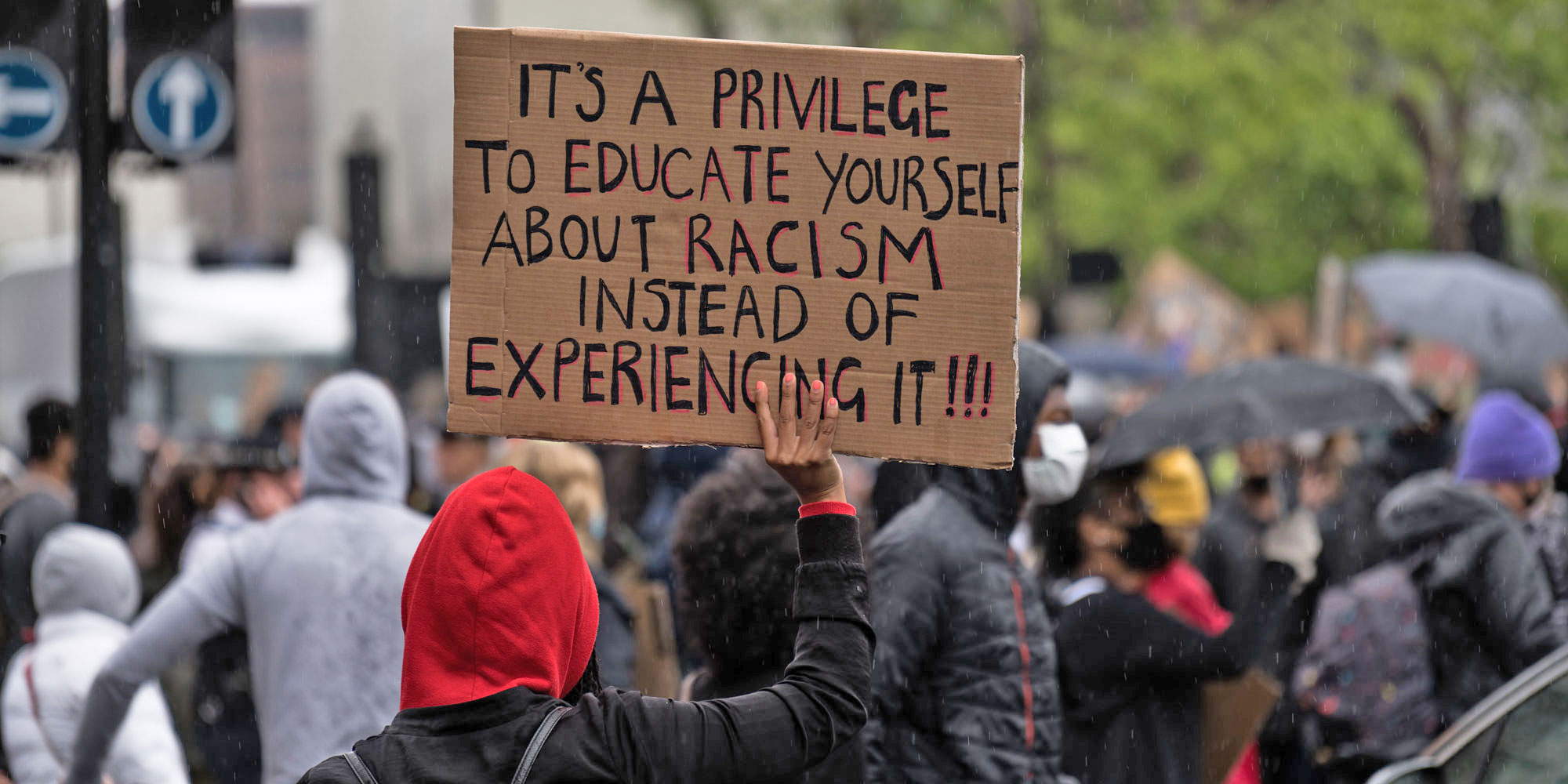
Why now and not before? And if not now, when?
One month ago, on May 25, the Minneapolis Police Department murdered George Floyd in a prolonged 8 minute and 46 second power play of intimate, knowing violence. News reports and interpersonal dialogue added qualifiers to Mr. Floyd, describing him as an unarmed, innocent Black man who was not resisting arrest. Let’s start here. In part one of this two-week personal reflection on racism and white supremacy, let’s start by calling out why these qualifiers are problematic, dehumanizing, and part of an ingrained narrative that Black people are dangerous. If the opposite were true—if Mr. Floyd was armed or guilty or resisting arrest—would this be enough to justify the theft of life? And if he were not Black, or more pointedly, if he were white, would we mention those qualifiers at all? Would he still be alive?
Mr. Floyd’s murder provided momentum for a worldwide movement demanding racially just laws, protections, and rebuilt systems. And while some were distracted by biased news coverage of destruction and instigative, violent rhetoric, others started paying attention. Mr. Floyd is not the first Black man to die at the hands of police, nor has he been the last. His death was not the first to be captured on video, nor was it more outrageous than video evidence of previous victims. What made May 25, 2020 different?
In trying to understand why I, too, felt mobilized, I kept circling back to COVID-19, inadequacies in public health infrastructure, inequities in public health communication, disproportionate health vulnerabilities, and racial disparities in COVID-19 outcomes. In addition to reminding us that structural racism is woven into how our country functions, the pandemic has revealed overt unfairness and privilege. We saw this in how differently police responded to armed people protesting the economy’s shutdown compared to how they responded to nonviolent people marching for justice.
And when I looked beyond the people in power and with power, I noticed that tens of thousands of people in my community cared about Black Lives enough to act in solidarity in light of and in spite of the worst public health emergency of our generation.
Scientific American
National Public Radio
Channeling discomfort into action
As I’ve processed grief and anger in this past month, I’ve learned that these emotions become more meaningful when they move away from reactions of the ego and towards humble, serious commitments to step up.
The Weekly Topic's readership consists of professionals and leaders in animal health, food safety, public health, and veterinary medicine. I don’t yet know the racial makeup or personal experiences of my audience. I know that I am a white woman in veterinary medicine and public health, two institutions in which I am grateful to learn, teach, and work. I have also benefited from my privilege in progressing in and advancing these fields. And I recognize that I have a duty to get it right, not just for my colleagues and this profession, but also for the communities, clients, and patients I took an oath to serve.
Understanding this, here’s where I started my own learning.
Back to basics: racism is not just bigotry
The systems that have weaponized the power of law enforcement and advantaged white people are the same systems that educate us, employ us, fund our research, and influence our methods, analyses, policies, and health recommendations. Like COVID-19, racism is a public health emergency and unpacking it begins with understanding that racism is both overt and insidious.
Normative culture reduces the embedded nature of racism to people’s individual choices to verbally or physically harm another person on the basis of their race; choices, perhaps, that can be fixed with compassionate learning and understanding. These are examples of individual level, interpersonal racism involving assumptions and behaviors that arise from personal prejudice. These biases occur between individuals and manifest as racial violence or slurs. They stem from internalized racism which occurs within individuals. These are privately-held beliefs that reflect what our society values and considers normal. Examples include believing that you are entitled or superior because of your race. Or, if you are not a person of privilege, internalized racism involves accepting that your own intrinsic worth is less because of cultural values that reinforce this notion.
Internalized and interpersonal racism are intrinsically linked, and they are supported and sustained by systemic level oppression. Institutional racism occurs within and between institutions or systems of power like schools, law enforcement, and health care. This manifests as discrimination (eg. not believing a Black patient’s description of symptoms) or inequitable advantages (eg. receiving pain relievers). It also involves unfair policies that support the success of some people and disadvantage others.
Structural racism is the normalization of all of this. It involves the “historical, cultural, institutional and interpersonal [dynamics] that routinely advantage whites while producing cumulative and chronic adverse outcomes for people of color. It is a system of hierarchy and inequity, primarily characterized by white supremacy – the preferential treatment, privilege and power for white people at the expense of Black, Latino, Asian, Pacific Islander, Native American, Arab and other racially oppressed people” (Lawrence and Keleher, 2004).
American Journal of Public Health: Levels of Racism: A Theoretic Framework and a Gardener’s Tale
Multicultural Resource Center: Levels of Racism
Structural Racism
What’s next?
Next week, we will reflect on why it is important to move beyond diversity and inclusion statements and translate this awakening into sustained, deliberate changes in the institutions from which many of us benefit. For now, start here:
African American Policy Forum: Under the Blacklight series
Race, Power, and Policy: Dismantling Structural Racism
White Privilege: Unpacking the Invisible Knapsack
TEDx talk with Dr. Camara Jones: Allegories on Race and Racism
